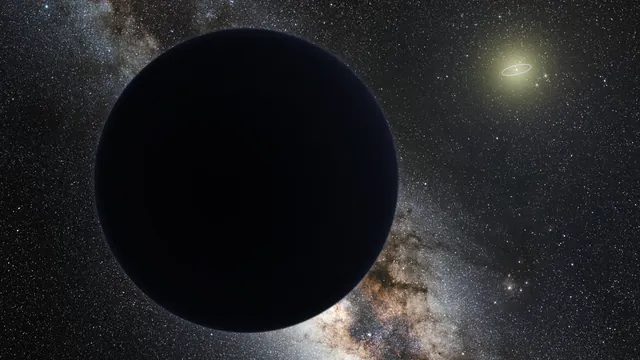
A Shocking Discovery: New Dwarf Planet Challenges Planet Nine Theory!
2025-05-30
Author: Jacques
Astronomers have made an exciting breakthrough with the discovery of a potential new dwarf planet at the far edges of our solar system, raising questions about the existence of the elusive Planet Nine.
Meet 2017 OF201: A Mysterious Distant World
Introducing 2017 OF201, an object that has taken the astronomical community by storm. "We were thrilled to uncover 2017 OF201, as it was entirely unexpected," exclaimed Sihao Cheng, the head of the research team from the Institute for Advanced Study in Princeton.
What makes 2017 OF201 intriguing is its distinct orbit. Its farthest point from the Sun, known as the aphelion, stretches a staggering 1,600 times farther than Earth's orbit, while its closest point, or perihelion, is a mere 44.5 times Earth’s distance from the Sun, sharing similarities with Pluto's orbit.
Exploring the Outer Solar System: A Frontier of Discoveries
The outer solar system is a realm full of mysteries, primarily located beyond Neptune in the Kuiper Belt—a ring of icy bodies and dwarf planets like Pluto. This vast area, starting 30 astronomical units from the Sun and expanding to 50 AU, is currently being examined by NASA's New Horizons spacecraft.
Beyond the Kuiper Belt lies a region known as the Scattered Disk, stretching potentially over 1,000 AU, inhabited by icy objects on eccentric orbits, shaped by gravitational forces from Neptune and nearby stars. Yet, despite the advancements in our understanding, much about the Scattered Disk and the distant Oort Cloud remains shrouded in mystery.
A New Entry into the Dwarf Planet Club
Currently sitting 90.5 AU from the Sun, 2017 OF201 boasts an impressive orbital journey that stretches 24,256 years. Estimated to be around 435 miles (700 kilometers) across, it’s classified as a dwarf planet, although still notably smaller than Pluto.
Past techniques would have struggled to reveal 2017 OF201, as it was fainter than Pluto and too distant for detection for most of its orbit. Thankfully, advancements in telescope technology and imaging surveys have made its discovery possible.
Planet Nine Faces a New Rival: The Challenge of 2017 OF201
The emergence of 2017 OF201 introduces puzzle pieces that complicate the Planet Nine hypothesis. This theory, proposed by Caltech's Michael Brown and Konstantin Batygin, suggested the existence of a super-Earth-sized planet influencing extreme TNOs (Trans-Neptunian Objects). However, the unique orbit of 2017 OF201 doesn’t align with the expected clustering of these orbits caused by Planet Nine's gravity.
Cheng highlights the potential implications: "While Planet Nine allows for scattered orbits, it renders them unstable over millions of years. Yet, the process that elevated 2017 OF201 into its current orbit took billions of years, suggesting it may have just recently arrived in this position. Hence, Planet Nine may not have had the chance to disrupt its path yet."
Hidden Worlds in the Shadows of Our Sun
Remarkably, 2017 OF201 may not be the only one of its kind. It only comes within a detectable range for 1% of its orbital lifespan. This raises the tantalizing possibility that hundreds of similar objects could be lurking in the depths of our solar system.
Cheng maintains, "The presence of this single dwarf planet hints at many more waiting to be discovered. The vastness of space still holds secrets about our solar system that are yet to be unveiled!"
The excitement surrounding 2017 OF201 illuminates the continuing quest for knowledge in our cosmic neighborhood. Who knows what other marvels lie hidden, waiting for the next generation of astronomers to uncover?









 Brasil (PT)
Brasil (PT)
 Canada (EN)
Canada (EN)
 Chile (ES)
Chile (ES)
 Česko (CS)
Česko (CS)
 대한민국 (KO)
대한민국 (KO)
 España (ES)
España (ES)
 France (FR)
France (FR)
 Hong Kong (EN)
Hong Kong (EN)
 Italia (IT)
Italia (IT)
 日本 (JA)
日本 (JA)
 Magyarország (HU)
Magyarország (HU)
 Norge (NO)
Norge (NO)
 Polska (PL)
Polska (PL)
 Schweiz (DE)
Schweiz (DE)
 Singapore (EN)
Singapore (EN)
 Sverige (SV)
Sverige (SV)
 Suomi (FI)
Suomi (FI)
 Türkiye (TR)
Türkiye (TR)
 الإمارات العربية المتحدة (AR)
الإمارات العربية المتحدة (AR)